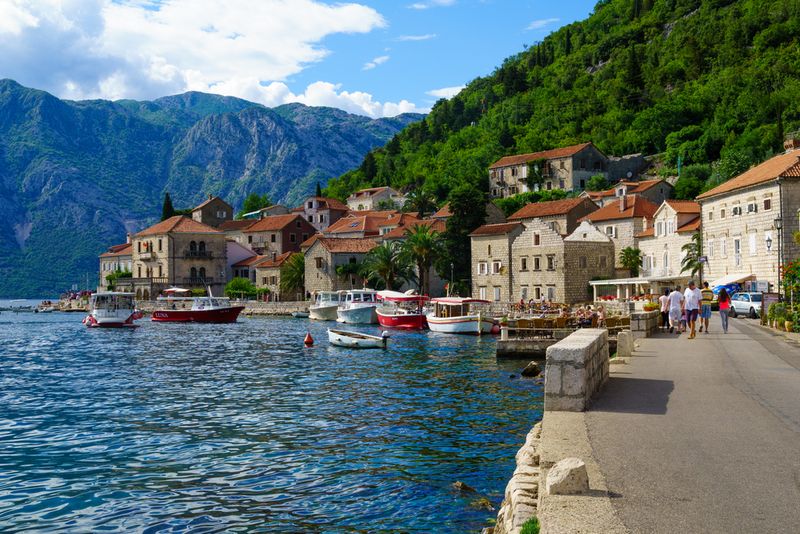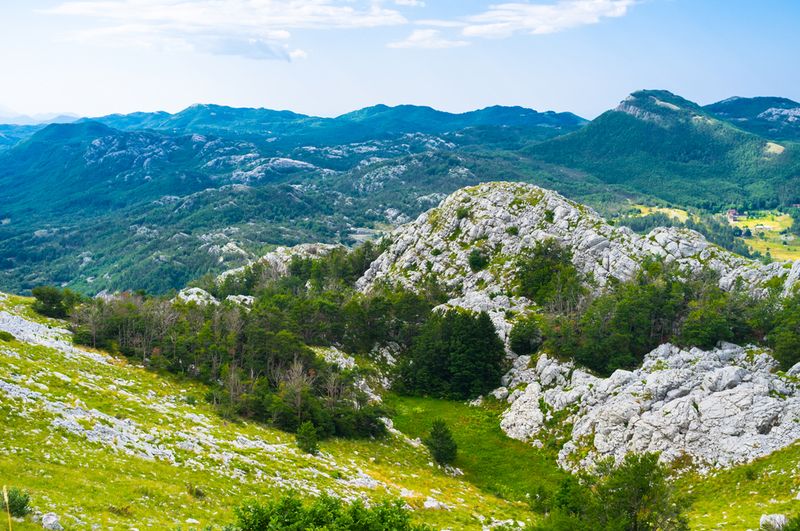
Montenegro: a Balkan country so small, most people have no idea where it is. Located between Albania and Croatia, this small but mighty country is quickly becoming a must-see on all European routes. For such a tiny country (you could drive from one end to the other in three hours) there is so much to see and do, a week isn’t nearly enough time. Anyone who spends time here understands why it is so special; the spectacular natural landscape alone is enough to cement Montenegro’s celebrity status, but this country offers so much more. It is jam packed with historic and important landmarks, and the towns have so much Baltic character they seem to come straight out of a story book. On top of that, the culture is intoxicating and the people are so welcoming- this country definitely won’t stay hidden for long!
Advertisement
7. Sveti Stefan
Formerly a playground for the wealthy- Elizabeth Taylor and Kirk Douglas both frequented the Sveti Stefan resort. Sveti Stefan is usually the postcard picture for Montenegro. Originally an old town built on a small island right off shore, about six km from Budva, it is now an upscale hotel and is actually closed to the public (unless you are willing to pay about 1000$ a night for a room)! It is remarkably beautiful though, and provides travelers with great photo opportunities, both from the road above and the beach down below!

6. The Ostrog Monastery
A monastery of the Serbian Orthodox Church, this Montenegrin landmark, built in the 17th century, is an architectural marvel constructed right into a near vertical cliff side. The Ostrog monastery is the most popular pilgrimage in Montenegro, and often thought of as the Balkan version of Petra. It is an incredible landmark and usually included in day excursions around Montenegro. The winding road leading up to the monastery is perilous, but, if you can brave it, open your eyes because the view from the road is breathtaking.

5. Kotor
Kotor is a beautiful historic town, filled to the brim with charm and intrigue. Many people head straight for Budva when visiting Montenegro- the nightlife is bumping and the beaches are filled with sunbathing tourists, but that’s pretty much all Budva has to offer, which is why you should head to Kotor instead. Koto is a coastal town located near the end of the Bay of Kotor, which means it is quiet and intimate, while still having an energized, local atmosphere. Kotor is a UNESCO town, surrounded by a walled fortress. Climb to the top of the fortress (about 1500 steps) for incredible views of the bright blue bay and surrounding hillsides. The food in Kotor is delicious, and the history is present at every winding turn. This town is pure character, and choosing it as a base to explore the rest of the country is a satisfying decision.

4. Perast
Another small UNESCO town located on the Bay of Kotor, Perast has so much character and personality it almost doesn’t seem real. The town is home to less than 500 people and is car free, which means it is a peaceful and beautiful escape from the busier Kotor. The water is crystal clear for swimming, and the beaches are never really busy. Out in the water from Perast you can see two tiny islands, Our Lady of the Rock and St George- if you want you can rent a boat to visit the two. Perast is beautiful and unique, with old Balkan architecture and plenty of history, it is pretty close to paradise here!

Advertisement
3. Cetinje
Slightly more difficult to reach than the coastal Montenegrin towns, Cetinje is a wonderful, little historic town nestled in the hills of central Montenegro. As the Old Royal Capital of Montenegro, history and charm is not lacking here. Founded in the 15th century, wandering the streets takes you back in time; it was the center of Montenegrin life and culture for years, and because of its heritage it is considered today the honorary capital of Montenegro. From here you can easily explore Mount Lovcen, a natural landmark of Montenegro, or the surrounding farm plains and tiny villages that decorate them. There are many historical interest points, such as the Cetinje Monastery and Vlaska church, but time is best spent here absorbing the culture, walking the streets and admiring the historic town life.

2. Lovcen National Park
Mount Lovcen, a mountain and national park in southwestern Montenegro, is a stop on most visitors’ itineraries. Rising high above the clouds, people say on a clear day you can see nearly the entire country; it certainly seems that way as the skyline up top never ends. The mountain slopes are rocky but they can be hiked by climbers with experience. The beauty of Mount Lovcen though, is anyone can reach the peak, via car or bus! On the top of the mountain is the Mausoleum of Njegos, a tiny, historical building with a paved path leading out to the top. The views from here are incredible, so spend some time basking in the marvel of the park and the whole of Montenegro before heading back down!

1. Tara River Canyon
Tara River Canyon is the longest canyon in Montenegro and, at its deepest point, is the deepest river canyon in all of Europe. The Tara River is a place so perfectly sculpted it doesn’t seem real; the water is too blue, and the canyon walls too dramatic. The uniqueness of the river makes it the ideal place for white water rafting and kayaking; in fact, lots of tour companies offer day trips to the gorge and back. The designated rafting route along the river is about 11 miles long and usually takes about three hours- more if you stop for some swimming! The Tara River is a haven for adventurers, but it is so striking that those not wishing to raft will want to visit anyways!

Advertisement